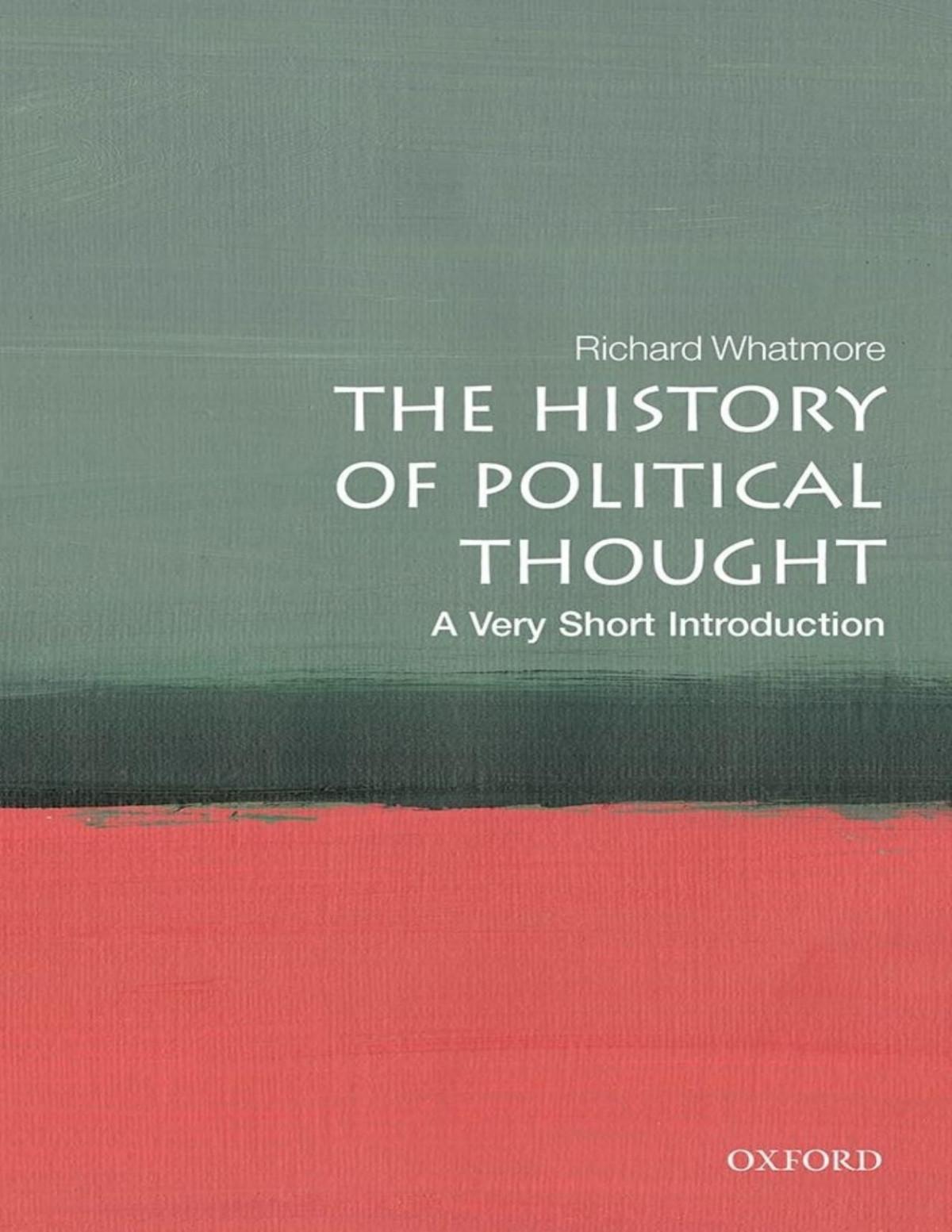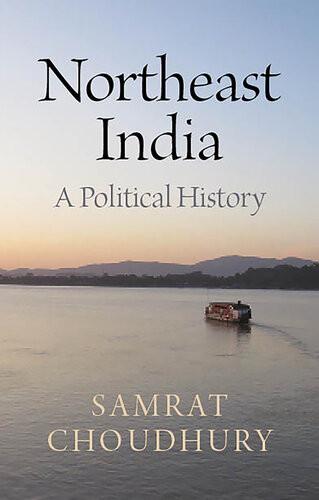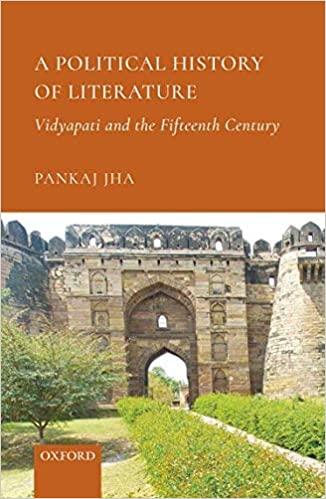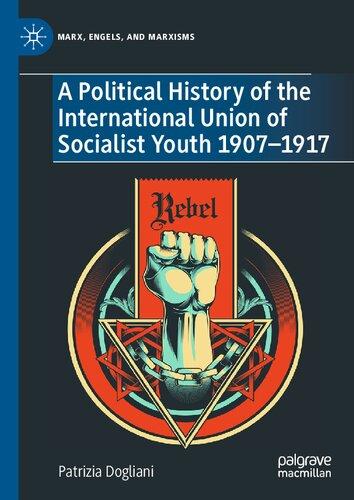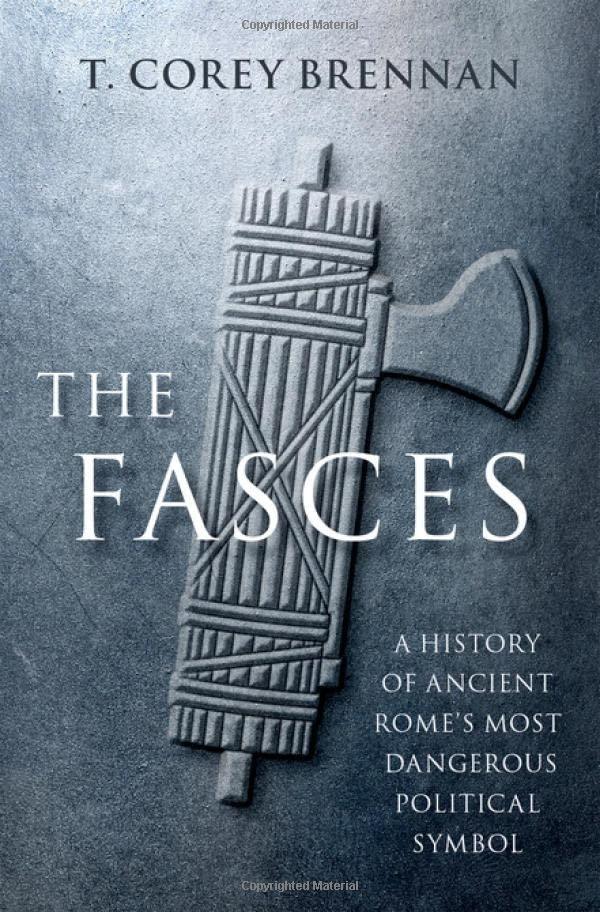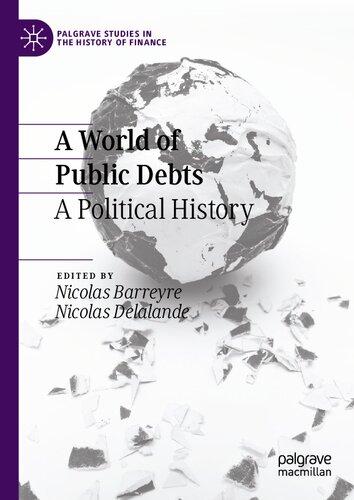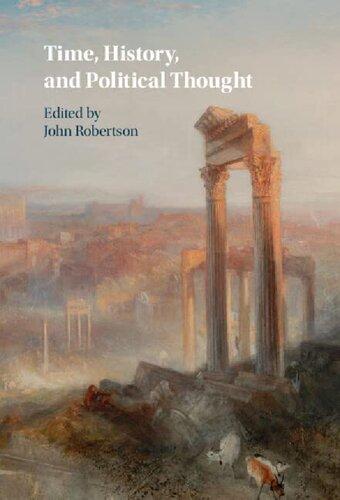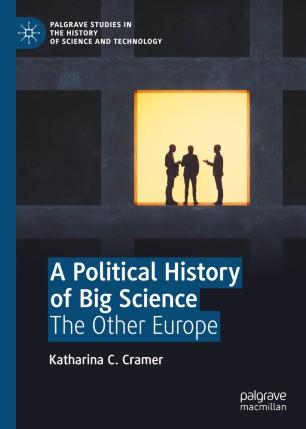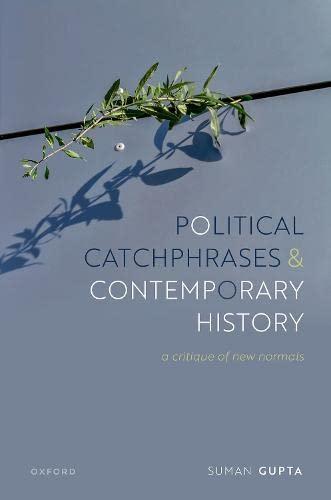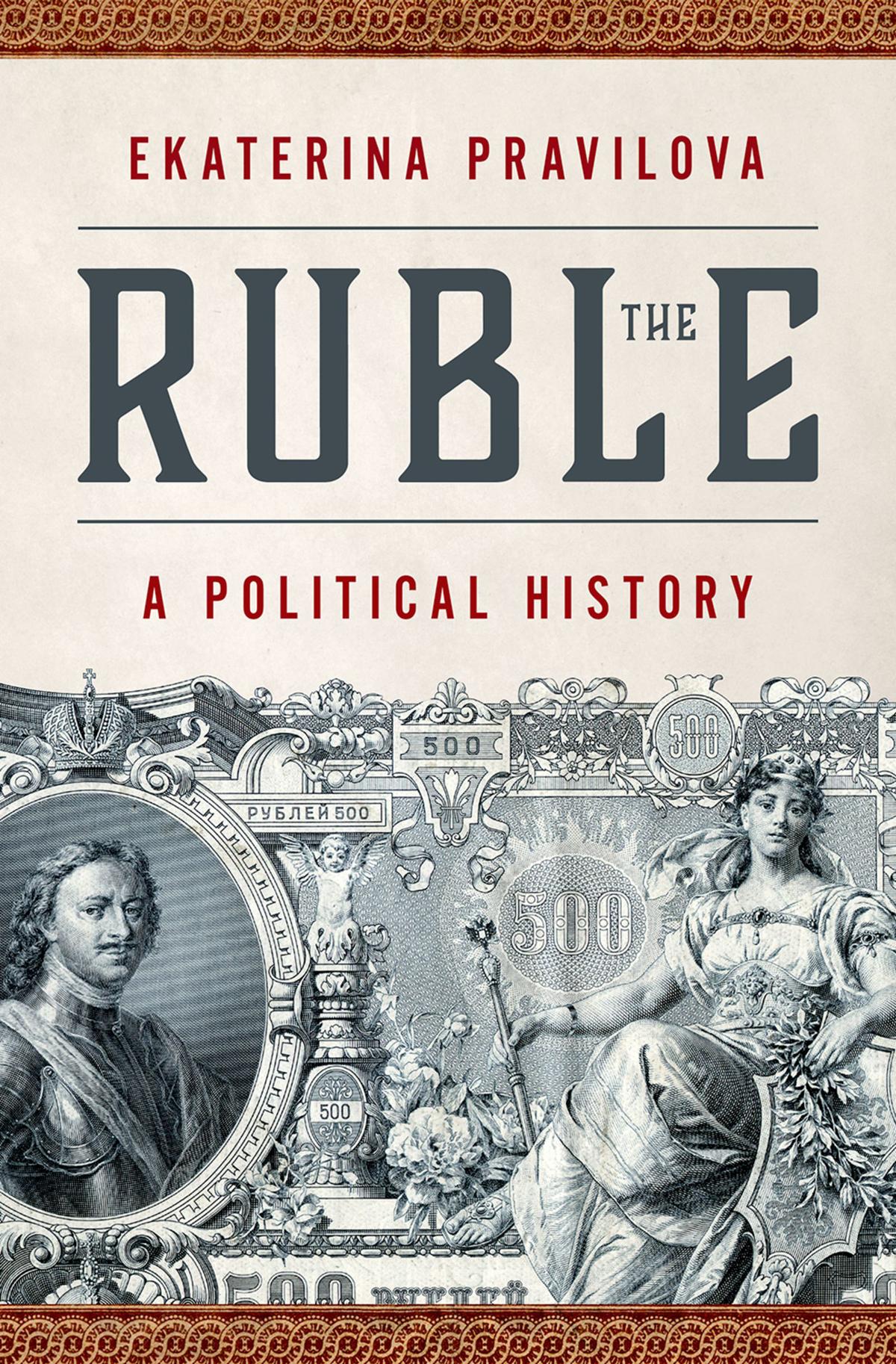The Ruble APoliticalHistory
EKATERINA PRAVILOVA
Oxford University Press is a department of the University of Oxford. It furthers the University’s objective of excellence in research, scholarship, and education by publishing worldwide. Oxford is a registered trade mark of Oxford University Press in the UK and certain other countries.
Published in the United States of America by Oxford University Press 198 Madison Avenue, New York, NY 10016, United States of America.
© Oxford University Press 2023
All rights reserved. No part of this publication may be reproduced, stored in a retrieval system, or transmitted, in any form or by any means, without the prior permission in writing of Oxford University Press, or as expressly permitted by law, by license, or under terms agreed with the appropriate reproduction rights organization. Inquiries concerning reproduction outside the scope of the above should be sent to the Rights Department, Oxford University Press, at the address above.
You must not circulate this work in any other form and you must impose this same condition on any acquirer.
CIP data is on file at the Library of Congress
ISBN 978–0–19–766371–4
eISBN 978–0–19–766373–8
DOI: 10.1093/oso/9780197663714.001.0001
In memory ofmy teacher, Boris Anan’ich (1931–2015)
Contents
Acknowledgments
Introduction: The Ruble’s Stories
Part I The Age of Assignats
1. Assignats: From Paper Substitutes to Paper Money
2. Autocracy or Representation? The Political Philosophy of Money in the Age of Napoleon and After
3. The End of Assignats
Part II Autocratic Capitalism
4. Paper Money in the Era of the “Great Reforms”
5. Ruble’s Wars
Part III The Gold Reform
6. Witte’s Rollercoaster
7. The Autocratic Standard
8. Practicing the Gold Standard
Part IV Ruble, Wars, and Revolutions
9. The Gold Syndrome
10. War and the End of the Gold Ruble
11. A Revolution That Did Not Happen
Epilogue: The Ruble That Cannot Be Spent
Appendix
Notes
Bibliography
Index
Acknowledgments
When I told my friends that I was writing a history of Russian money, some shrugged their shoulders and felt sorry for me. Others were very excited to hear about the project and welcomed my idea, and I am grateful for their enthusiasm. I am also grateful for the opportunity to prove that studying money, especially the ruble, can be fun and rewarding.
It would be impossible to name everyone who has helped me in research and writing. I especially appreciate the generous support offered by Princeton University, my academic home since 2006, and the John Simon Guggenheim Memorial Foundation, which funded my sabbatical year in 2018–2019 and paid for several trips to the archives in Moscow and St. Petersburg. In Russia, many archivists and librarians were very welcoming, friendly, and helpful. My special gratitude goes to an expert in Russian numismatics, historian Andrei Bogdanov of the Goznak’s Museum of Money in St. Petersburg. He introduced me to the museum’s extraordinary collection and responded to multiple questions and queries. Anastasia Poverin, Maria Starun, and Azat Bilalutdinov helped me to collect and systematize materials in libraries and archives, which was especially important when COVID-19 made traveling difficult, if not totally impossible. Thomas F. Keenan, Princeton University’s Slavic librarian, has been indispensable in tracking down rare publications and locating sources that I was desperate to find. Kristen Kapfer worked to improve the text of the manuscript at its early stage.
I was lucky to be able to present the concept of the project before COVID-19 put academic meetings on hold. The feedback that I received from my colleagues at the Russian history kruzhok at Columbia University, the German Historical Institute, and the Centre for Modern Russian History at the Higher School of Economics in
Moscow was essential for shaping the concept of my research. Presenting this work at the Shelby Cullom Davis Center for Historical Studies at Princeton University was a privilege. I am grateful to the Center’s then director Angela N.H. Creager for the opportunity to brainstorm the politics of the ruble with my Princeton colleagues. Graduate students, but most important, Geoffrey Durham and Friedrich Asschenfeldt, have read and commented on the chapters of the manuscript and provided their insights. I was glad to find out that my interest in the fate of Russian money during the First World War and the revolutionary era was shared by William Rosenberg. I benefited enormously from reading Bill’s chapters from a forthcoming book on the Russian economic and social crisis and comparing our interpretations of this period. Anne O’Donnell offered excellent advice, and we had many conversations about finance, property, and economy in the revolutionary era. Stephen Kotkin’s opinion about my version of the early history of Soviet finance meant the world to me (of course, he does not bear responsibility for any of my mistakes). Harold James, Stefan Eich, Yanni Kotsonis, and Francis Wcislo read the entire manuscript in its pre-edited, more extended version and wrote extensive comments and suggestions that I followed faithfully. I admire their academic comradeship and owe them for the project’s significant improvement in concept and argument. Finally, Susan Ferber of Oxford University Press has helped me to turn the manuscript into a book. I am grateful for her hard work, patience, and professionalism.
Many other friends and colleagues have supported me in ways I cannot even explain. Naming everyone would take dozens of pages. My conversations with Igor Fedyukin, Katia Deminsteva, Ilya Vinitsky, Monika and Helmut Reimitz, Anna and Michael Meerson, and Tatiana Borisova have been especially important. Igor Khristoforov, my husband and a fellow historian, knows about imperial money and banks no less than I do, and I often sought his advice in research and writing. My parents, Natalya Vasilievna and Anatoly Mikhailovich, have always been my most enthusiastic supporters. Even though the history of money isn’t their subject, they tried to understand what exactly I was studying, and I did my best to explain.
This book is dedicated to the memory of my teacher, Boris Vasilievich Anan’ich (1931–2015), who spent more than three decades of his academic life studying the life of Serguei Witte and exploring Russian imperial finance. Boris Vasilievich was a fantastic adviser—very kind, warm, and endlessly generous. Everyone admired him, and he inspired many of his students to study economic and political history. He was also a great storyteller, and Serguei Witte, whom Boris Vasilievich often called simply “Count,” became a household name for us, while the history of the gold reform, Russia’s foreign loans, and its economic expansion appeared riveting and exciting. My interpretation of the gold standard and Witte’s policy may differ from Boris Vasilievich’s account. Still, I know that he would have been excited to hear it, as he always welcomed the most daring experiments of his students and colleagues. Without him, this book could not have been written.
The Ruble
Introduction
THE RUBLE’S STORIES
Can money have a story? Russian writers thought it could. Nikolai Novikov’s comic autobiography of a 25-kopeck coin (1778), Nikolai Bestuzhev’s AHistoryofa Silver Ruble(1820), TheAdventures ofa Blue Assignat by Evgenii Grebenka (1847), along with numerous other works, focused their narratives not on people but on the imaginative life stories of kopecks and rubles, coins and notes. The money’s journey spotlights the virtues, sins, fortunes, and misfortunes of people who hoarded coins and forged, stole, lost, exchanged, or gave paper rubles away. The long life cycle of money underscores humans’ fragility: rubles are resilient to crises, diseases, and starvation while people suffer and perish in poverty. Money seems passive, a silent witness to the deeds and misdeeds of men, but it is not; it is the invisible driver of petty tragedies, intimate dramas, and grand historical processes. The pre-revolutionary stories, most famously Leo Tolstoy’s epic TheForgedCoupon(1904, publ. 1911), are often dominated by moral didactic and reflections on the corrupting influence of money on human nature. Soviet “travelogues” and fairytales about money, such as Serguei Mikhalkov’s The Adventures of a Ruble (1969), straightforwardly deliver an ideological message about the advantages of the Soviet financial order over imperialist economies. In any case, both the old and the new hagiographies of the ruble exploit the anthropomorphic nature of money. Rubles come to life, like people, and die—some of them graciously, being melted into ornaments or burned in a bonfire in front of an imperial palace, others with jeering and mockery, as the despised Soviet “monetary signs” that, after the monetary
reform of 1921–24, lost their value and were replaced by “good” chervonetz.1
Such metaphoric parallels between humans and money are ageold. Sociologist Nigel Dodd’s TheSocialLifeofMoneyspotlights both the temporality of money (“money is a process, not a thing”) and its embeddedness in the fabric of society.2 Other scholars have highlighted the peculiar duality of money: it is at once a quintessentially fungible commodity devoid of any personal characteristics, yet it acquires a wealth of meanings—social, gender, generational, political, religious, and national.3 Thus, paradoxically, while the history of modern society is often told as a process of simplification and flattening—“making up people” to fit standardized categories—money appears in a palette of subtle meanings and identities.4 One can write a history of the dollar, the złoty, or the franc as a biography of a currency, with a focus on its role in politics, its financial career, or the aesthetic or material qualities of coins and banknotes. This book is a political biography of the Russian paper ruble, from its inception in the mid-eighteenth century to the reform of 1921–24. It considers money not only as a passive product of economic and constitutional organization, but also the active means of enacting (or preventing) changes in the political and legal structure of the state and society.5
Any biography is bigger than one person’s life story. Even when focusing on the extraordinary and unique lives of individuals, biographies spotlight the fates of whole generations, social groups, or nationalities. Similarly, a political biography of the ruble offers an opportunity to explore the political life of modern money, to reveal and explain the reasons for similarities and divergences between national currencies. The nineteenth century, known as a century of nationalism, brought an unseen universalization to the sphere of finance. It gave the world the modern idea of a monetary standard and international monetary unions that partially suspended national particularisms in the sphere of finance. In the 1860s–80s, the gold standard spread across Europe and North America and then reached beyond these two continents, creating an illusion of a financial
concordance based on a common monetary language. By the beginning of the twentieth century, adherence to the gold standard came to be seen as a virtue, while deviance from it was synonymous with failure. In economic history and the history of money, exceptionality often means abnormality, while the uniformity of criteria, standards, and rules is considered a higher good. Yet, despite the name, the principles of monetary standards were less “standardized” than it may seem. John Maynard Keynes noticed it in 1913, when he wrote about the futility of the attempts to follow the British model.6 But if financial models of the monetary standards differed, their political constituents demonstrated even more variety. Much can be found looking at how domestic politics and the specificity of political organization affected the monetary regimes in the silver- and gold-standard world. The Russian case is especially revealing.
Historians have long debated the idiosyncrasy of the Russian state and political culture. Some have tried to normalize Russia’s story by searching for non-European points of comparison and questioning the universality of the applied criteria of normalcy. Others have resisted smoothing over the story of autocracy and totalitarianism. Russian particularism in the sphere of finance has usually been bluntly called “backwardness.” Russia followed many European institutional patterns, but its currency remained inconvertible through most of its history. It was the last European great power to join the gold standard system despite its gold reserve being the largest in Europe. Russia avoided the turmoil of the nineteenthcentury European revolutions and remained an autocratic empire, yet a strong liberal movement simmered for decades, producing original, if oftentimes impractical, ideas. Russian society was attentive to European intellectual exchanges and was amazingly receptive to economic ideas coming from the West, yet many of the economic and political projects that were discussed in clubs, academic journals, and bureaucratic offices remained unfulfilled. The Revolutions of 1917 that followed the devastation of World War I swept away the old state with its monetary system, but the contours
of the new state that emerged on the ruins of empire bore the indelible features of its predecessor, and the new socialist ruble replicated its imperial ancestor. Without implying some inherent specificity (or pathology) of the Russian state and its society, The Ruble shows how they evolved in the context of Russia’s political, financial, and intellectual relationship with the West and the East.
In tracing the evolution of the ruble and the debates around it, this book translates the meaning of financial institutions and terms such as “convertibility,” “exchange rate,” “monetary standard,” “independence of the bank of issue,” and others into the language of politics. The political meaning of these terms was not the same 200 years ago as it is today. In the eighteenth century, when Catherine the Great introduced Russia’s first paper money, called “assignats,” paper notes were not considered real money but the “representative signs” of currency. To ensure the credibility of assignats, the state promised to make them exchangeable for copper and silver coins that were kept in the storage rooms of state Assignat Banks. But after the government discovered the ease of using paper money to cover extraordinary wartime expenses, it started issuing paper notes that were not “backed up” by the metal collateral. Due to various factors, but mostly overprinting, the value of assignats began to fall, and the government took up a new means of supporting their value —through references to the sublime power of the ruler. Thus, the idea developed that in an autocratic state, the value of paper money hinges on the sanctity of the sovereign’s promises rather than a material collateral. Assignats came to be seen as a projection of absolute authority.
Not everyone welcomed the idea of autocratic money. In the 1780s, Russian politicians versed in the economic ideas of the Enlightenment coined a concept of money as the representation of national wealth. It assumed that the nation owned the bullion reserve, and the government could not issue monetary signs that did not correspond to the value of this common asset. This idea was clearly very radical: it imposed limits on autocratic privileges and even indirectly suggested the political sovereignty of the people. But how could it be possible to restrict the authority of the monarch?
One way to do so was to demand the inviolability of the bullion reserve and the convertibility of assignats to specie. This arrangement made both economic and political sense: the reserve, as well as the convertibility of paper notes, was considered to be the best conditions of credibility not only domestically but also internationally. Therefore, a government seeking capital and investments would be interested in maintaining the reserve. However, simply holding a metal reserve equivalent to the amount of paper money in circulation did not guarantee the observance of the “rule of law” in finances. Sooner or later, the government (or the ruler) could succumb to the temptation to overprint. Therefore, proponents of the nation’s right to money suggested complementing material collateral with institutional guarantees, namely, the creation of an independent private (joint stock) bank of issue. Economists contended that in addition to the metal reserve, an independent central bank could back up currency with short-term bills of exchange that reflected actual commercial transactions. Such a bank was thought to represent the productive part of society and would release banknotes in the amount reflecting the demands for money in the economy.
The appearance of assignats, which coincided with the Westernization of Russian intellectual life and Russian society’s embrace of the Enlightenment, opened up questions of the state’s indebtedness to its own subjects. Russian thinkers compared the paper money’s convertibility to the right of political representation, while a banknote was seen as a mandate for participation in governance. The bullion reserve appeared crucial for maintaining the accountability of government and the separation of powers, and allegiance to a monetary standard was analogous to the rule of law. Furthermore, in Russian liberal nineteenth-century parlance, an independent bank that guarded the reserve, issued banknotes, and ensured their convertibility to specie stood for a parliament. This entire intellectual edifice rested on a presumption that the government derived its power of money issuance from the sovereign people, not vice versa.
The conservative theory that developed in parallel and in reaction to the liberal doctrine asserted that the request for additional material and constitutional guarantees of the paper ruble’s value contradicted the logic of imperial rule. In the monarchal state, the monarch’s pledge and honor were sufficient to support the value of money and the credibility of the state. Maintaining the reserve was seen as an unnecessary restriction of the state’s financial authority that infringed on the tsar’s sacred duties—to wage the war against enemies of the empire or Christian Orthodoxy and to protect the Fatherland. Russian conservatives were very unhappy with the rigor and doctrinaire nature of the liberal theory that, in their opinion, was very inflexible. They thought that the government of a growing empire required the freedom to issue paper money when it saw fit. Since the proponents of the nominalist theory associated monetary liberalism with the imaginary “West,” this theory acquired a nationalist bent. It developed into a concept of the “people’s ruble” that emphasized the Russian population’s unconditional trust in any kind of monetary signs issued by the state. Therefore, while liberals were embarrassed by the ruble’s inconvertibility, nineteenth-century nominalists considered it almost a virtue. The story of the Russian ruble deserves to be told if only to illustrate how Russian monarchists invented the indigenous paper standard and turned it into official ideology. No other country has ever produced such an odd ideological construct.
In the nineteenth century, as Russia turned into an active borrower on the international market of capitals, it had to somehow respond to the expectations of solvency. Therefore, economic conservatism further transformed the liberal idea of convertibility into something associated with monarchy rather than a constitutional right. These conservative financial ideas that combined autocracy with the concept of a monetary standard were original and not seen elsewhere in Europe. While liberals envisioned an independent bank that on behalf of the people held the reserve and ensured convertibility, conservatives considered it a royal asset that was meant to compensate, in the eyes of Russia’s creditors, for the lack of constitutional guarantees. If, as political scientist Stefan Eich
has argued, money “can help to create and maintain the precondition for . . . democratic politics,” it can also work in the opposite way.7 The Russian monetary system was designed to maintain autocracy.
Having rejected “Western” notions of good currency that were considered incompatible with the monarchal doctrine, the Russian imperial government invented its own vision of economic success and financial stability that matched the political principles of the autocratic state. After all, if political stability means the absence of revolutions, from this point of view, Russia until 1905 looked like an oasis of tranquility. Of course, this tranquility was misleading and could only be achieved through political repressions and censorship. In finance, conservative stabilization assumed fixing the ruble’s rate and preventing its fluctuation. But, similar to the visibility of political order that concealed widespread discontent, this stability of money was to a great extent maintained with the help of political and administrative measures. The Russian ruble was “fixed” on the silver standard in 1839, meaning that one paper credit ruble was equivalent to a silver ruble, and it switched to gold in 1897. Both reforms assumed an increase in bureaucratic surveillance over commercial activity and were predicated on the centralization of state power. In the mindset of the imperial administrators, the threat of instability came from the unpredictable and unruly market that was associated with speculation and the perils of bankruptcy and ruin. Of course, the government did not attempt to completely paralyze commercial activity and credit networks. But, while business and commerce were expected to develop, money had to remain solely within the purview of the state.
These attempts to destroy the influence of the market while aspiring for economic growth may seem staggering. After all, isn’t money one of its key components? Historians of money have by now dismantled the myth of money’s emergence from trade and exchange, and the origin story of the Russian paper ruble gives further evidence of money being created rather than naturally born.8 Yet although the state claimed its monopoly on the production of
money, it could not fully control the economic behavior of society and its attitude toward the ruble. To the chagrin of Russian administrators, when the ruble’s rate was unstable, people invented their own alternative measures of account, such as the “coin ruble” of the 1830s and the “bread rubles” of the Civil War. And if the government failed to supply the market with notes or coins that were in high demand, local communities started printing their own marks to compensate for the deficit of cash.
But the most apparent constraint on the state’s ability to control the ruble was its constantly fluctuating value. The problem of rate emerged simultaneously with the appearance of the assignats, and it represented more than a strictly economic issue. The ruble’s rate, as much as it represented the projection of Russia’s commercial activity, was seen as a reflection of Russia’s geopolitical standing or, more generally, Russia’s civilizational inferiority or superiority. Throughout the nineteenth century, debates over how to interpret the rate continued. The ruble’s falling rate affected the ability to buy imported commodities that, along with the introduction of European ideas, symbolized the Westernization of Russian elites. After the abolition of serfdom and the removal of most restrictions on credit and investment activities, Russian society plunged into the new realities of capitalism, and the ruble’s rate turned into one of the key parameters of everyday life. However, the majority of Russia’s peasant population did not consume imported goods or buy shares, and nationalists stressed this while trying to present the ruble’s rate as a form of Russia’s dependence on the West. Economic factors, such as the revenue from the export of grain or the costs of paying for foreign loans, mattered, but the rate was not exclusively a financial category. When Russia’s relations with the European great powers were especially frayed after the Russo-Turkish War (1877–78) and the Berlin Congress, the government pretended that it ignored the falling rate, considering the ruble’s demise in the wake of Russia’s victory a humiliation. A few years later, the situation was reversed. The same people who had suggested measuring the ruble’s value in pounds of wheat bread instead of francs or pence declared that the low rate of the ruble was an assault on the
emperor’s honor. Economists were also trying to figure out which factors—the amount of printed money, Russia’s trade balance, the size of its foreign credit obligations, or the successes of Russian army on the battlefields—affected the ruble’s standing.
Conversations about rate, convertibility, or the authenticity of money often revealed preoccupations with ethical and ideological matters and fundamental issues of honor, dignity, and trust. When Catherine the Great vouched for the convertibility of assignats and pledged to preserve their value, she endorsed the perception of rubles as the ruler’s promissory notes. The promise of exchange for specie printed on each assignat and, later, credit ruble enhanced this connection; when the assignat’s rate fell, writers lamented the “humbled” state of the ruble, referring to the dual meaning of the word dostoinstvo as both dignity and nominal value. The honor argument appeared in different contexts and meanings. In 1862, for example, the government, with inadequate preparation, rushed to resume the exchange of paper rubles for gold, referring to its duty to fulfill the promises of the deceased tsar (Nicholas I). However, in 1876, on the eve of the Russo-Turkish War, nationalists argued that the honor of protecting the Slavs from the Ottoman Turks was more important than the dishonor of the ruble’s falling rate. In 1896, when news of the projected devaluation of the ruble got into the press, critics of the reform characterized it as a violation of the honor code, comparing the government to an untrustworthy merchant. The ruble, which is supposed to be neutral and fungible, often appeared in an anthropomorphic form—as a person, with soul, honors, and dignity. The “honor” arguments especially dominated the conservative discourse. Nationalist critics of political economy offered a heavily romanticized vision of monetary relations, blaming liberal economists for their heartless, mechanical approach to money. True, the liberal version of trust stressed transparency and control, science, and evidence, which offended the sensibilities of their opponents.
What appears important in the context of the ruble’s story is that monetary ideology and patterns of financial policy were always embedded in larger systems of ethics, culture, epistemology, and
history.9 Consequently, the rift between conflicting ideologies was much deeper and more substantial than often thought, and it was not limited to institutional preferences. If, as Austrian sociologist Karl Mannheim wrote, conservatism (and likewise, liberalism) represented “styles of thought,” then the analysis of money offers a perfect opportunity to explore these modes of thinking.10 The choice of the vector for monetary policy was often justified by historical and philosophical references. For instance, in the first half of the nineteenth century historians and policymakers were immersed in a debate over the existence of leather (or skin) money in pre-Mongol Rus’. This seemingly peripheral question in fact had enormous importance. The nationalist proponents of Russia’s indigenous paper standard, who refused to measure the ruble’s worth in silver or foreign currencies, argued that Russia had introduced a prototype of paper currency centuries before it appeared in Western Europe. They presented fiat money as a culturally advanced form because it required abstract thinking while the use of coins and banknotes tied to a metal reserve, betrayed a more primitive form of economic judgement. The historical debate first and foremost concerned Russia’s relations with the West and the role of the state as the driving force of cultural and economic progress. The argument about Russia’s role and civilizational superiority expressed in its (doubtful) precedence in inventing fiat money corresponded to the nationalist view on Russian language and its development. Arguing for the priority of the state in determining the amount and value of monetary signs, nationalists also asserted the government’s right to purge foreign words and introduce a new Russian vocabulary based on indigenous roots.
The ruble, therefore, served as a compass that helped to locate Russia on the economic and political map of the world. Parts of the Russian Empire also belonged to the financial “West.” The Kingdom of Poland and the Grand Duchy of Finland at different periods of their existence enjoyed monetary autonomy, while their currencies were oriented toward their European neighbors. After the failed revolutions of 1831 and 1863, Poland lost its currency, along with
constitutional privileges and autonomy. In 1860 Finland was allowed to introduce its own monetary sign, and in 1876, it switched to the gold standard, thereby creating a source of constant embarrassment for Russian liberals and nationalists. All major monetary reforms— the silver reform of 1839–43, the introduction of the gold standard in 1897, and the Soviet chervonetz reform of 1921–24—aimed to facilitate the inclusion of borderlands into the ruble domain. While standing on the economic “East” from its own Western borderlands, Russia enjoyed the status of a civilizational “West” in relation to its own Orient, the Asiatic borderlands and protectorate territories. After the introduction of the gold standard, Russian government looked down on the silver-based currencies of Bukhara and Manchuria and tried to make the population switch to the “superior” gold-backed rubles. Administrators considered the expansion of the ruble domain as a part of Russia’s civilizing mission and were genuinely puzzled over why the local population did not want to abandon their “inferior” money in favor of the “better” ruble. The ruble was not always a good (and cheap) tool of imperial management and integration, but the ideological reasons for turning it into the only currency of empire outweighed all practical considerations. While trying to spread rubles to the remote corners of the Empire or even beyond its borders, the government was often responding to the conflicting demands of local elites, regional authorities, Russian merchants, and diplomats. The politics of money was, therefore, not limited to state governance; different actors used the ruble argument in bargaining with the state. Money was a universal language for communicating grievances and expressing expectations —not only between regional authorities and the center, Russian and non-Russian elites, but also between various social groups and the government. Russian society was deeply stratified into estates and classes, and bargaining between the government and the people during the imperial and the early Soviet period often occurred along these lines. Merchants and noblemen, and sometimes peasants or those who spoke on their behalf, expressed visions of their own ideal ruble and the parameters of the socially just monetary system and asked the government to act as the arbiter in these relations, to
prescribe, discipline, police, and prohibit. More often than not, they disagreed, arguing that the economic behavior of other social groups was detrimental to the fate of the “common ruble.” These debates, starting with the campaigns against luxury in the 1780s, when merchants accused noblemen of causing the inflation, to the antipeasant sentiments during World War I and the Civil War, when peasants were blamed for hoarding money, demonstrate how social actors used the ruble rhetoric to manipulate the state and how the government used those demands to justify or postpone unpopular reforms.
Not all social interactions surrounding the ruble took the form of peaceful bargaining. Sometimes they evolved into different forms of conflict and resistance, drawing the masses into political participation, sometimes inadvertently and unpredictably for the state. The women’s riots of 1915, in reaction to the deficit of small change, certainly could not match the violence of the Copper Riot of 1662 caused by the replacement of silver coins by copper, but these riots were equally spontaneous and expressed the moral economy of money as people understood it. The social protest in response to monetary policy rarely escalated to the level of rebellion, but, as anthropologist James Scott underscores, the “weak” can use other weapons and means to express discontent.11 The silent refusal of peasants to sell grain for depreciated rubles during the Civil War of 1918–21 is an example of this form of resistance, but so too are counterfeiting in the villages of Old Believers, which reached an unseen scale during the financial crisis of the 1860s, and the widespread refusal to take gold coins after the reform of 1897. These and other episodes show that people perceived the unwritten rules of monetary circulation as the indispensable elements of the tacit contract between the state and society. In the seventeenth century as well as in the first years after the revolution, people treated money as a public good that the state had to provide. In their eyes, money was society’s property that the state had agreed to manage. The authorities did not share this attitude. Policymakers often spoke about the obligation of the tsar’s subjects to accept
depreciated money and therefore share the burden of financing the state. The denial of the people’s claims was symptomatic of the deep political cleavage that separated the rulers from the ruled, a cleavage that ultimately triggered mass discontent. The February Revolution of 1917 at once exposed the extreme politicization of financial problems. Workers and soldiers who had hoped that the fall of the tsarist government would improve their condition blamed the new republican authorities for their failure to salvage the ruble and stop inflation that eroded the social achievements of the revolution. After the October coup, the new socialist power openly declared that the ruble was the weapon of class war used to expropriate wealth from the enemies of the proletariat. When the Civil War and the violence of class purges brought the socialist republic to the brink of the catastrophe, the government turned to the reconstruction of the financial and administrative system. Astonishingly, this reconstruction included the return of the imperial ruble based on the pseudo-gold standard that assumed the centrality of the state and constraints on the free market of credit. A revolution in finance did not happen.
The history of the ruble is told here in different registers. One line of inquiry focuses on intellectual trajectories—the imaginary lives of the ruble reflected in the projects of reforms, pamphlets, newspaper articles, treaties, and academic books. Through these texts, the book traces the evolution of two approaches to money: as a socioeconomic institution and the mandate for rights, and as a proxy of power and the source of obligation. These two concepts corresponded to two worldview—one cosmopolitan and focused on the rule of law, another isolationist and predicated on the primacy of power. The analogy became obvious: a proposition of a financial reform aimed at restoring convertibility, along with establishing an independent bank of issue, was deemed equivalent to a demand for a political constitution and the limitation of autocracy. Therefore, this line of inquiry reveals previously unknown trends and sources of Russian liberal and constitutional thought. Including the ideas of
financial constitution and the rule of law expands and enriches understanding of the Russian tradition of constitutionalism.
Not only did the type of texts dedicated to the ruble vary but so too did the professional occupations and political profiles of their authors. Journalists, ministers, and professors of political economy argued over their priority and expertise in solving financial problems. In the era when political economy came into vogue, especially in the 1860s–90s, many deemed themselves able to converse about the rates of exchange, trade balance, and credit policy. The government was very perceptive about changes in public opinion and believed that its swings could affect the ruble’s standing. Therefore, as the massive volume of correspondence between ministers and journalists shows, controlling newspapers and cultivating good relations with writers and editors constituted one of the key areas of activity at the imperial Ministry of Finance. Battles over the ruble took place in clubs, learned societies, and public meetings attended by well-dressed women and students. The ruble’s imaginary “adventures” in novels, poems, and short stories mirrored the most routine and bizarre features of the social life of money and its place in society.
A second line of inquiry in the ruble’s story is the materiality of money. While people experienced the results of big shifts in monetary organization and economic policies, the most immediate and visible effects came with the physical changes of bills and coins —new images, shapes, and textures. As it grappled with the economic problems of rates, convertibility, and credit, the government was also preoccupied with the mundane tasks of ensuring the authenticity of bills, their resilience to counterfeiting, and their material quality, all of which were seen as key elements maintaining popular trust in currency. That was especially important because in the world of money based on standards or replete with imaginary units of account, a banknote or a coin was supposed to straddle the space between the matter of money and the imaginary value that it designated. In Russia, this dichotomy was expressed in language. For example, the “silver ruble” (rubl’serebrom) as a legal tender was represented not only by paper notes but also by copper
coins that bore an inscription “1 (or ½, 2 and 3) silver kopeck,” reflecting the financial alchemy that could turn one metal into another. After the introduction of the gold standard in 1897, and its resumption in 1922, the paper ruble was made gold (rubl’ zolotom) in actuality (with gold coins minted in new denominations) and figuratively. All these changes were reflected in the design of money, with special attention paid to formulating the values and the promises. The logistics of making money also created physical horizons for political decisions. The Bolshevik government, overwhelmed by inflation and unable to satisfy the demand for cash, was forced to use tsarist money with two-headed eagles and tsars’ portraits until the end of the Civil War and the normalization of currency.
Through the analysis of texts, ideas, policies, and practices, the political history of the Russian ruble creates an alternative vision of the emergence, growth, and collapse of the Russian Empire, through the crisis of the revolution, to the end of the Civil War and the beginning of the New Economic Policy (NEP). The rhythm of the story appears quite conventional, punctuated by the accessions and death of rulers, the sequence of wars and reforms, the dynamics of expansion, and the formation and the dissolution of the imperial domain. Yet, by telling this story from the point of view of Russia’s national currency, this book refutes many myths and stereotypes while clarifying important phenomena and processes. Among many things, it addresses the problem of autocracy and explains the economic implications of an unlimited political power. It discusses the genealogy of constitutionalism and redefines the meanings of liberalism and conservatism, as well as the notions of economic development and backwardness. It also reconsiders the significance of the Revolutions of 1917 and questions the radicalism of revolutionary changes in the spheres of economy and governance.
The book’s chronological narrative is arranged in four parts. Part I: “The Age of Assignats” begins with Catherine the Great’s main
financial reform: the introduction of assignats and the creation of Assignat Banks (Chapter 1, “Assignats: From Paper Substitutes to Paper Money”). The story of the assignats’ birth reveals a conundrum that many other countries of eighteenth-century Europe faced at that time, namely, how to reconcile the political ideas of the Enlightenment with the financial exigencies of imperial expansion and growth. For Russia, this problem was even more complex because, unlike its European counterparts, the Russian monarchy had not developed the mechanisms of borrowing from domestic elites, which would have required political bargaining. Thus, paper money, secured by a collateral in copper coins, appeared as the first instance of the state’s domestic debt. By introducing assignats in 1769, Catherine II inadvertently subjected the Russian monarchy to scrutiny. From the very moment new money was released into circulation, her courtiers were plunged into a debate about the nature of money and the essence of the sovereign’s rights and obligations. Trying to figure out how to frame these relationships in political terms and how to boost Russia’s political credibility as a rule-of-law monarchy without affecting its financial means, Russian thinkers advanced a notion that was novel and radical even for prerevolutionary Europe: they designated the empress’s subjects as the owners of the bullion reserve that backed up the value of paper money and described paper assignats as the ruler’s debt to the people. However, as the analysis of this financial policy demonstrates, institutional arrangements—most importantly, the status of Assignat Banks—contradicted these lofty ideas. The government continued to print money excessively, and the paper ruble’s value vis-à-vis its metal equivalent and other currencies plummeted.
Chapter 2, “Autocracy or Representation?” explains how the Napoleonic Wars sealed the fate of Russia’s constitutional and monetary reforms. It traces the development of the political concepts of money in the first quarter of the nineteenth century—the period of Alexander I’s reign, when intensive debates about the virtues of constitutional rule over unlimited monarchy unfolded against the background of near-constant warfare, which brought the
ruble to the brink of collapse. In the minds of Russian reformers, the two issues—monetary and political—represented two sides of the same coin: a constitutional reform presupposed the introduction of a financial rule of law, while financial stability was unthinkable without limiting the power of monarchy. Mikhail Speransky built this dual principle into his reform plan of 1809 which was introduced in a severely truncated form, without a free Silver Bank or a representative legislature. The conservative opposition to Speransky’s reforms, which prevailed on the eve of Napoleon’s invasion in 1812, annulled his monetary innovations, including, most important, the silver standard, and proclaimed the ideas of a metalbased ruble incompatible with monarchy.
Chapter 3, “The End of Assignats,” focuses on the 1830s through the 1850s, the period known through Alexander Pushkin’s poetic works and Nikolai Gogol’s stories, which are replete with money riddles and metaphors. Indeed, the monetary system of post–Napoleonic Russia looked as phantasmagoric as Gogol’s tales, with several currencies—paper and metallic—circulating in parallel and creating perplexing systems of measuring and counting. In an attempt to fix this anomaly, the government in 1839 initiated a monetary reform that ended the era of assignats and introduced a new kind of paper currency: silver-based credit rubles. Chapter 3 decodes the meaning of the reform by focusing on the philosophical and political views of its main ideologue, Egor Kankrin [Georg Cancrin], who translated the political principles of Nicholas I’s ideology of Official Nationality into the language of money. Along with Kankrin’s project of the reform, the tsar and his functionaries briefly considered a model based on the Bank of Poland and its convertible złoty banknotes. However, the Polish alternative, which evoked Poland’s constitutional past and its financial independence, had no chance of being adopted. Moreover, the monetary reform, conducted according to the tsar and Kankrin’s plan, opened the way for the financial russification of Poland through a gradual introduction of rubles. Although the reform based the ruble on silver, it conspicuously rejected the principles of state accountability for the issuance of paper money.
Unable to withstand the pressure of the Crimean War, Nicholas I’s monetary system collapsed even before the tsar’s demise, and Russia entered the era of the so-called Great Reforms with an inconvertible ruble. Part 2, “Autocratic Capitalism,” opens with Chapter 4, “Paper Money in the Era of the Great Reforms,” which asks whether the scale of the monetary reforms of the 1860s matched the radicalism of the changes in society, law, and the rural economy (including the emancipation of peasants). Did the waves of Westernization, liberalization, and decentralization that reformed Russia’s public institutions and even its structures of everyday life transform the ruble as well? Although the financial reforms of the 1860s rebooted the credit system, and the government receded from several areas of financial activity, leaving more space for private initiative, the political principles of Russia’s monetary economy remained untouched. The key element of the reform, namely, the de-governmentalization of money and the transformation of the State Bank into an autonomous institution, was left out of the reform plan; at the same time, the projects introducing a representative legislature were rejected in the final stage of their preparation. Still, the ideological and cultural effect of the Great Reforms could not be undone. Russia entered the age of capitalism, and attitudes toward money and wealth changed dramatically. Russians traveled, invested in bonds, and mortgaged lands in private banks, bought shares, and anxiously followed the movement of rates. While financial publicity and popular monetary literacy dramatically increased, Russian society came to see the ruble through different political and social lenses. The depreciation of Russian currency contrasted starkly with people’s elevated expectations of economic prosperity.
After an unsuccessful attempt to restore the ruble’s convertibility in 1862–63, the government embarked on a program of gradual financial restoration, amassing gold in the State Bank and slowly preparing for another reform. This process ended abruptly in 1877 when Russia entered another war with the Ottoman Empire. Chapter 5, “Ruble’s Wars,” focuses on a remarkable period in the ruble’s life, when, after the end of the Russo-Turkish War, the Ministry of
Finance, which pursued financial austerity and the ruble’s restoration, was attacked by conservative and nationalistic journalists who enjoyed the patronage of the tsar and succeeded in removing the minister of finance, Nikolai Bunge. In the absence of political parties, newspapers and their editors assumed the role of the leaders of public opinion. Among the various components of state national identity, the nationalists singled out currency as a symbol of Russia’s distinctiveness, turning the ruble’s inconvertibility into a virtue. Conservative criticism of “Western” financial principles revealed not only growing discontent among nobility and commercial elites with the government’s stringent policy but also elites’ anxiety over the prospect of joining the monetary realm of Western Europe, which in the 1870s had switched to the gold standard.
Part III, “The Gold Reform,” tells the story of the reform’s prelude, preparation, and realization. Chapter 6, “Witte’s Rollercoaster,” foregrounds famed financial reformer Serguei Witte. Witte joined the government under the flag of conservative and nationalist policy, which in financial terms meant inflationism. His plan to increase the volume of paper money was linked to the economic appropriation of Russia’s borderlands through the construction of waterways and railroads, the resettlement of peasants, and the development of the agrarian economy. Although Witte, disappointed with the financial efficiency of inflationism, became an ardent supporter of the gold standard in 1895, he did not abandon his political stances. The gold reform of 1897 pursued the same objectives as those advocated by Witte’s earlier conservative mentors, such as the concentration of the government’s power over the production of money. As Witte reasoned, the gold ruble represented a better tool than a paper ruble to accomplish the objective of imperial expansion.
Chapter 7, “The Autocratic Standard,” offers a radical reconsideration of the monetary reform of 1895–97 and emphasizes the centrality of political mechanisms in determining the financial results of monetary innovations. The gold reform manifested a new iteration of financial nationalism that was fully compatible with both the orientation toward the West and the creation of favorable conditions for foreign investments. To explain the meaning of the

